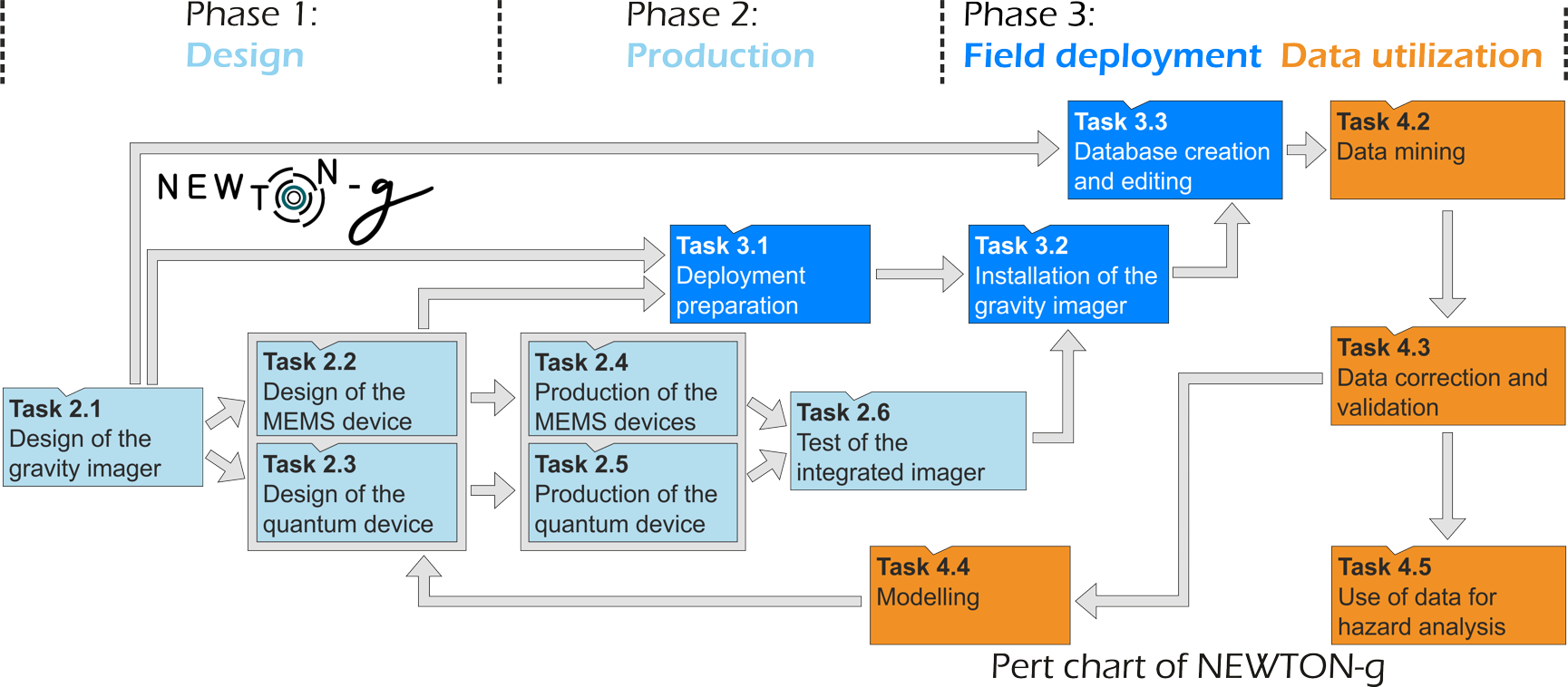 |
The implementation of NEWTON-g involves three main phases:
|
|
▶
design
▶ production
▶ on-field application |
|
Design (year 1) |
During the first phase, mutual feedback between geophysicists that specialize in gravity studies and geophysical modelling
(INGV, KNMI, GFZ) and physicists at Muquans and UNIGLA-IGR will define the required capabilities of the quantum and MEMS gravimeters. The characteristics of the
gravity changes that are expected at Mount Etna will be quantified in terms of their magnitudes and time scales. Furthermore, we will identify the characteristics
of the typical installation sites at different distances from the active craters of the volcano in terms of (i) available structure to house instrumentation;
(ii) available power; (iii) available space for equipment; and (iv) typical variation in daily and seasonal environmental conditions. All these factors will inform
the design of the quantum and MEMS gravimeters. Indeed, we will look for advantageous trade-offs between the following requirements: (1) achieve suitable sensitivity
and long-term stability for observing the expected volcano-related gravity changes; (2) reduce the size of the equipment in order to make it as light and portable as
possible; (3) minimize the power required by the gravimeters; (4) ruggedize the instruments to ensure their operation even under harsh conditions; (5) reduce the
costs of instrument production and maintenance; and (6) make the instrumentation as easy to use as possible. |
|
Production (year 2) |
During the second phase, the development of the instruments will be completed, including joint laboratory tests on the prototypes.
The latter will be aimed at assessing the potential for the production phase to achieve manufacture of devices with the required capabilities. This phase will also involve
close interaction between physicists and geophysicists to understand how data from the laboratory experiments will translate to expected results from field deployments. |
|
Field deployment and data utilization (years 3 and 4) |
During the third phase, the newly developed MEMS and quantum prototype gravimeters will be tested in the field.
We will deploy the gravimeters at Mt. Etna, where the advantages over other locations include: (1) a 30-year history of gravity
measurements to provide context for NEWTON-g deployments; (2) existing infrastructure to support field operations; (3) abundant volcanic activity, likely associated with gravity
changes during the timescale of the project; and (4) existing multi-parameter monitoring of the volcano, which can be used to aid in the interpretation
of gravity signals; (5) relatively easy access to the summit crater zone. Mount Etna is also one of only a few volcanoes in the world where time-lapse and continuous gravity measurements
are routinely performed already. In particular, a mini-array of three superconducting gravimeters (SGs) has been in continuous operation at Mount Etna since the summer of 2016. To our knowledge, these are the first SGs
ever installed on an active volcano. Analyses of these data demonstrate the ability of these instruments to detect even small gravity changes due to volcanic processes that occur over a wide
range of time-scales (minutes to months). Furthermore, continuous and time-lapse observations are regularly completed using spring gravimeters on an array that includes more than 70 field
stations. Absolute measurements are also made on a regular basis at the few sites on the flanks of the volcano where portable instruments can be operated. The gravity imager developed under the project can,
therefore, be evaluated against existing technologies in terms of performance, resolution, and utility.
|
 |
